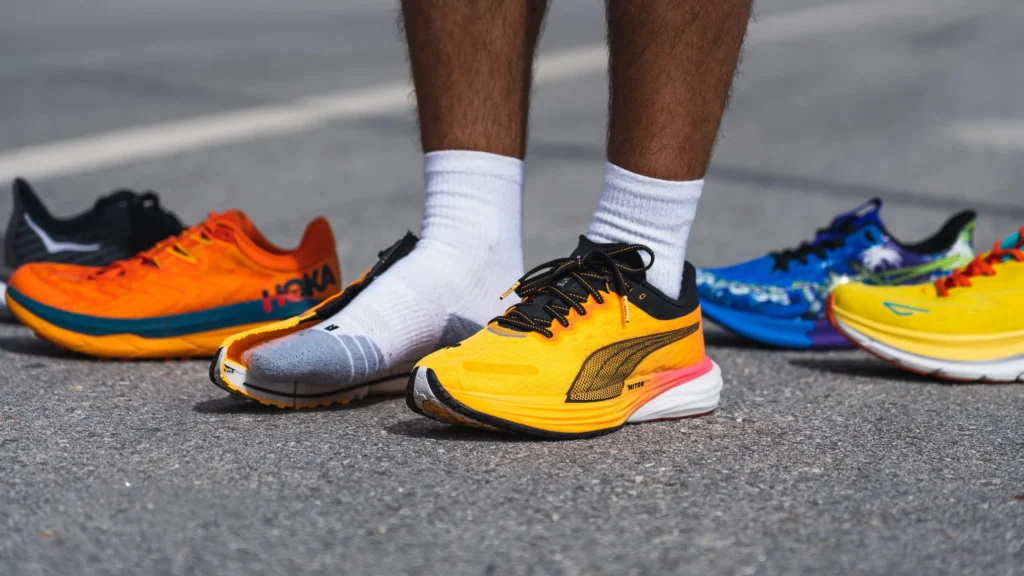When it comes to running, the right pair of shoes can make all the difference. Whether you’re a seasoned marathoner or just starting your jogging journey, choosing the perfect running shoes can help prevent injuries, improve performance, and keep you comfortable on every stride. But with so many brands, styles, and technologies out there, how do you know which pair is right for you? This comprehensive guide breaks down everything you need to consider, from foot type to terrain, ensuring you make the best choice for your unique running needs.

1. Know Your Foot Type
Your foot shape plays a major role in determining the right shoe. The three main arch types are:
- High Arch (Underpronation): Your foot rolls outward. Look for cushioned shoes with lots of flexibility.
- Normal Arch (Neutral): Your foot rolls inward slightly. Choose stability shoes with balanced support.
- Flat Foot (Overpronation): Your foot rolls inward excessively. Motion-control shoes help with this.
To determine your arch, try the wet foot test: wet your foot, step on a piece of cardboard, and observe the shape left behind.
2. Understand Your Gait
Gait refers to the way your foot strikes the ground when you run. A professional gait analysis at a running store or with a podiatrist can help you determine whether you pronate, supinate, or have a neutral stride. This will guide you toward the right shoe category and avoid injuries like shin splints or plantar fasciitis.
3. Match Shoes to Terrain
The terrain you run on affects the kind of shoe you need:
- Road Running Shoes: Designed for pavement, they are lightweight with cushioning.
- Trail Running Shoes: Built for rough terrain, they have aggressive tread patterns and rugged soles.
- Track Shoes: These are lighter and offer speed but less cushioning.
Choosing shoes that match your running environment will enhance grip, stability, and comfort.
4. Don’t Ignore Shoe Fit
Fit is one of the most crucial aspects of selecting running shoes. Make sure there’s about a thumb’s width of space between your longest toe and the shoe’s end. The shoe should feel snug in the heel and midfoot but offer wiggle room in the toes. Always try on shoes later in the day when your feet are slightly swollen—this mimics the foot shape after a run.
5. Know the Shoe Types
Understanding the main types of running shoes helps you narrow down choices:
- Neutral Shoes: Great for runners with normal pronation.
- Stability Shoes: Provide light support for slight overpronation.
- Motion Control Shoes: Best for heavy overpronators or those with flat feet.
- Minimalist Shoes: Lightweight with low heel drop, mimicking barefoot running.
- Maximalist Shoes: Feature maximum cushioning for long-distance comfort.

6. Don’t Chase Trends
Popular shoes aren’t always the best choice for your unique foot and running style. Rather than going with the latest release or influencer-recommended pair, prioritize fit, function, and performance. A stylish shoe that doesn’t support your foot correctly can lead to injuries.
7. Consider Shoe Weight
Lighter shoes are ideal for speed work and races, while heavier shoes with more cushioning may be preferable for long runs or recovery days. Finding the right balance depends on your running goals.
8. Factor in Durability
Running shoes typically last between 300 to 500 miles, depending on your running style, weight, and surface. Check for signs of wear, such as a compressed midsole or worn-out tread. Some runners rotate between two pairs to extend longevity.
9. Break Them In Gradually
Avoid running a marathon in new shoes. Gradually break in your shoes with shorter runs to allow your feet to adapt and prevent blisters or discomfort. This also helps you catch any fitting issues early.
10. Know When to Replace
Signs that you need new shoes include:
- Pain or discomfort during or after runs
- Noticeable wear on the sole or midsole
- Loss of cushioning or arch support
Keeping a log of your shoe mileage can help you plan replacements before injuries occur.
10 FAQs About Running Shoes (100 words)
1. How often should I replace my running shoes?
Every 300–500 miles, depending on use and wear.
2. Can I run in walking shoes?
No, running shoes offer more support and cushioning for impact.
3. Are expensive running shoes worth it?
Not always—fit and comfort are more important than price.
4. Do I need different shoes for trail and road running?
Yes, trail shoes offer better grip and protection.
5. Can I wash my running shoes?
Yes, hand-wash gently with mild soap and air dry.
6. What’s heel-to-toe drop?
It’s the height difference between heel and toe—affects foot strike.
7. Should running shoes feel tight?
They should feel snug but not tight, with toe room.
8. Can I use orthotics in running shoes?
Yes, but make sure shoes have removable insoles.
9. How do I avoid blisters?
Choose moisture-wicking socks and well-fitting shoes.
10. Are minimalist shoes good for beginners?
Not usually—start with more supportive shoes first.
Choosing the perfect running shoes may seem overwhelming, but with the right knowledge, you can find a pair that supports your stride, matches your terrain, and keeps you comfortable every step of the way. Happy running

